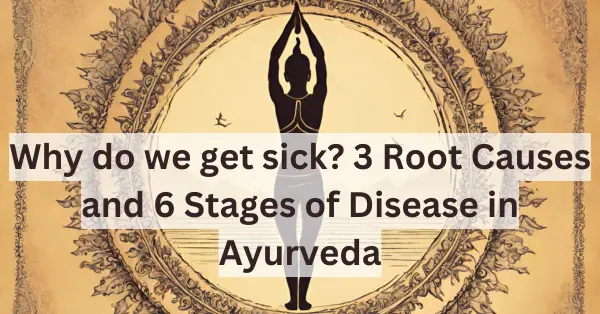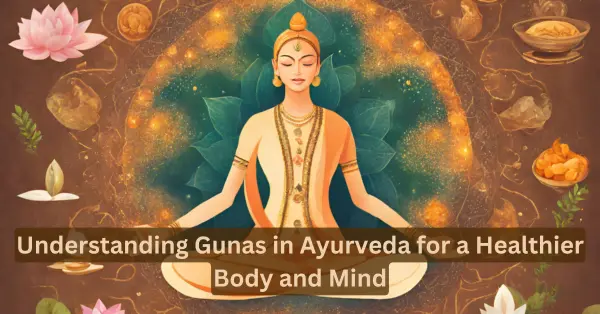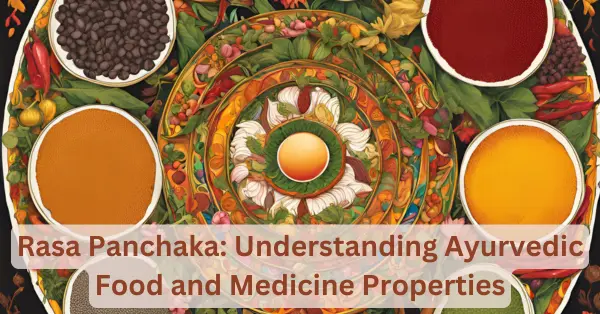Ayurveda has a holistic approach to health and disease. One of the main teachings in Ayurveda is that diseases don’t appear instantly but follow a progressive path that develops over time.
The science of Ayurveda has preventive and restorative measures. It not only focuses on the symptoms but also on the progression and the root cause of the illness.
Definition of Disease in Ayurveda
The disease is called Vyadhi in the Sanskrit language. According to Ayurveda, when any factor reverses the flow of the ease of the body, it’s called disease or Vyadhi.
In technical Ayurveda words, when the three doshas (Vata, Pitta, and Kapha) are out of proportion or balance according to an individual’s Prakriti (Ayurveda Body type).
3 Root Causes of Disease in Ayurveda (Trividha)
1. Prajnaparadha (Misuse of intellect)
2. Parinama/Kala (Seasonal influence)
3. Asatmendriya Artha Samyoga (Improper coordination of senses with their organs)
These three causes (asatma indriyartha samyog, prajn apradh, and parinama) are the root cause of any disease.[1]
3 Key Causes of Disease in Detail
1. Prajnaparadha (Misuse of intellect)
Prajna = Wisdom and Apardha = Offence. Misuse of wisdom or an offence against wisdom.
Simply put, it’s doing things without discriminating, whether good or bad, favorable or unfavorable.
We know what we should do, but still, we do the opposite.
It aggravates three doshas and two gunas (Rajas and tamas)
Examples of Prajnaparadha
1. One has eaten and is full, yet keeps eating because it’s so tasty.
2. One is very tired but continues to work instead of taking a rest.
3. When we know smoking, alcohol, watching violent movies, and excessive talking harm us, we still do it.
4. Staying up late without sleep to watch Netflix
5. Also, Prajnaparadha in its normal state leads to health.
2. Parinama (Time or Kala)
Seasonal Variations: Unnatural or extreme variations in temperature cause Parinama. E.g., sudden rainfall or wind.
It’s divided into three categories
1. Hina Yoga (Mild) Parinama – Very mild temperature variations
2. Ati Yoga (Extreme) Parinama – Unexpected extreme climatic changes. E.g., excessive heat in summer or cold in winter.
3. Mithya Yoga (Opposite) Parinama – Opposite to normal variations. Cold in summer or Warm/hot in summer.
Different disorders related to specific ages of life also fall under Parinama.
Examples
1. Not adjusting the diet and lifestyle according to the seasonal changes.
2. Not following a lifestyle according to age.
3. Asatmendriyaartha Samyoga (Misuse of senses)
Asatmya=Improper, Indriya=sense organs, Artha=object of sense organ, Samyoga=combine.
Improper contact of the senses with their objects
This results in over-stimulating or a deficiency in sensory activity
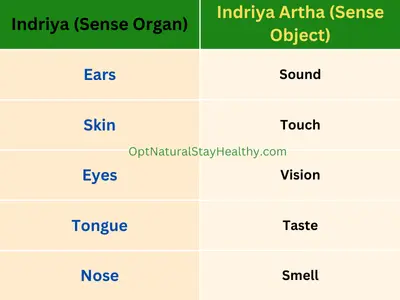
Similar to Parinama, it also has three categories.
1. Hina Yoga Asatmendriyaartha
Insufficient contact of the sense organ with an object. eg- A person running in a hurry skips to see the wet floor and falls.
2. Ati Yoga Asatmendriyaartha
Excessive contact of the sense organ with the object. eg- Watching TV for hours or staring at the phone all the time.
3. Mithya Yoga Asatmendriyaartha
Incorrect contact of the sense organ with the object. eg- Reading books under dim light or in a sleeping posture.
6 Stages of Diseases in Ayurveda (Shat Kriya Kala)
During the early stages, the disease doesn’t manifest completely. The person only has a few to no symptoms.
The disease can’t be diagnosed in the early stages by lab investigation, and by the time it’s diagnosed, it’s too late for prevention.
The great advantage of Ayurveda is that it can identify the imbalance in the dosha before it manifests as a disease. It allows Ayurvedic practitioners to take remedial actions and reverse the imbalances at an earlier stage of development. Thus, preventing the emergence of full-blown diseases.
Kriyakala, a distinctive concept in Ayurveda, offers insights into both diagnosing and foreseeing how a disease might progress.[2]
Prevention has always been the first and the major goal of Ayurveda.
Samprati – Six stages of disease in Ayurveda
1. Sanchya – Accumulation Stage
2. Prokapa – Aggravation Stage
3. Prasara – Overflow Stage
4. Sthan Samshraya – Localisation Stage
5. Vyakti – Manifestation Stage
6. Bheda – Differentiation or Complication Stage
By detecting a disease before the 5th stage, a disease can be reversed easily.
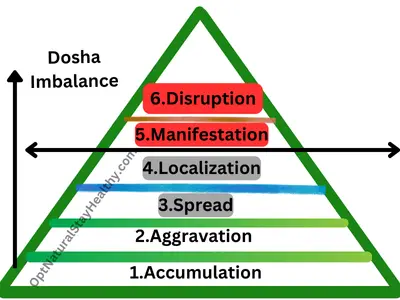
6 Stages of Disease in Detail
In the first two stages, there are no visible symptoms; in the third stage, there are vague symptoms such as fatigue, which becomes more expressive in the fourth stage. In the fifth stage, symptoms of a specific disease manifest.
As the disease progresses from stage one to stage six, the imbalance in the doshas increases.
By detecting a disease before it goes to the stage of manifestation, the disease can be reversed very easily. Knowing the six stages of the disease can help in diagnosing the disease as early as possible.
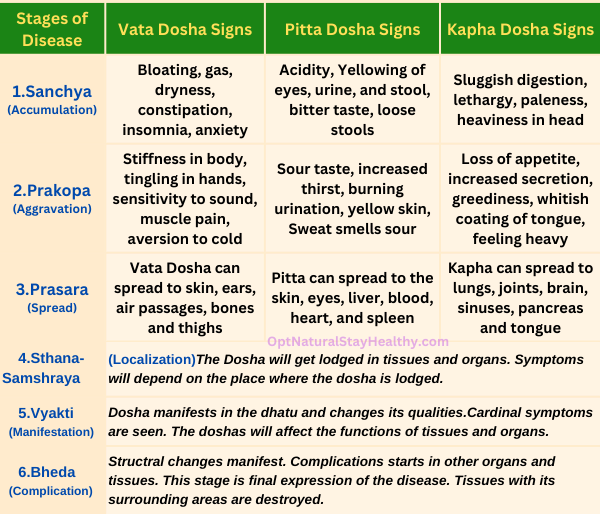
1. Sanchya – Accumulation Stage of Disease
Sanchya is a Sanskrit word that means accumulation. In this first stage, the dosha begins to accumulate in its site.
Every disease begins with the accumulation of one or more doshas. There can accumulation of any one, any two, or all three doshas,i.e. vata, pitta, kapha, or all three doshas.
Vata, Pitta, and Kapha govern all the body functions. When these three doshas remain balanced, the person enjoys good health, peace, and harmony. Due to a bad lifestyle, unbalanced diet, stress, and environmental changes, one or more of these doshas can get imbalanced. This imbalance of doshas is the main cause of all the diseases in Ayurveda.
For example, the Vata dosha may accumulate in the colon or the empty channels of the body. Pitta dosha may accumulate in the digestive tract, eyes, and skin. The Kapha dosha may accumulate in the chest, joints, fluids, and circulatory system. There is a quantitative change in the doshas in this stage
Ayurveda symptoms of Sanchya
In the first stage, if the Vata dosha is accumulating, you may find the symptoms of bloating, gas, dryness, constipation, insomnia, and anxiety.
If Pitta dosha accumulates, the person may discover acid formation in the stomach (acidity), yellowing of the eyes, urine, and stool, loose stool, and bitter taste in the mouth.
If Kapha dosha accumulates, the person may feel sluggish digestion, lethargy, paleness, and heaviness in the head.
2. Prokapa – Aggravation Stage of Disease
The dosha begins to increase in its site. It begins to rise in its place. There is a qualitative change in the doshas in this stage. Symptoms of specific doshas manifest during this stage. Most of us suppress the symptoms with over-the-counter medication in this stage.
This stage can’t be identified or diagnosed by lab investigations.
Ayurvedic Symptoms of Prokapa Stage
In this stage, if Vata is increasing or aggravated, the person will feel stiffness in the body, tingling in the hands, sensitivity to sound, muscle pain, and aversion to the cold.
If Pitta aggravates, the person will feel a sour taste in the mouth, increased thirst, burning urination, yellow skin, and sweat that smells sour.
If Kapha, the person will feel a loss of appetite, increased secretion, greediness, whitish-coating of the tongue, and a general feeling of heaviness.
3. Prasara – Overflow Stage of Disease
In this stage, the dosha leaves its site and spreads via the general circulation to the different parts of the body.
This is the dissemination or spreading stage. In this stage, the doshas that are already aggravated in the second stage (Prokopa stage) begin to circulate in the entire body. Doshas enter the plasma and blood and are no longer in their seat. This dosha comes in contact and mixes with the tissues and the body’s waste material.
There are no specific symptoms. Low-grade, non-specific symptoms such as pain and mild malaise can be seen at this stage. The patient may complain of mild fatigue in this stage.
Symptoms of Prasara Stage
In this stage, if the Vata dosha spreads to the entire body, the Vata can spread to the skin, ears, air passages, bones, and thighs.
If Pitta dosha spreads, it can affect the skin, eyes, liver, blood, heart, and spleen.
If Kapha dosha spreads, it can affect the lungs, joints, sinuses, pancreas, brain, and tongue.
4. Sthan Samshraya – Localisation Stage of Disease
The dosha finds a weak spot in the body and localises or deposits in this spot. The spot or the place is the healthy tissue. Once it deposits on the healthy tissue, it manifests with pathological changes in the tissue, hence producing cardinal signs and symptoms.
In this stage, dosha localises in the tissue outside of its main seat and begins to disrupt the function of that tissue or organ.
Several factors determine where the spreading doshas will locate themselves. Doshas can move to any site in the body through the circulatory system and settle to the weak spot in the body.
Ama is a digestive toxin; it is a sticky substance and easily clogs the micro-circulatory channels.
Dosha that spreads carry the ama with it. This sticky substance gets localised where there are narrow channels in the body. Dosha with the Ama after localising in a particular part becomes a breeding ground for diseases. This is the beginning of the actual disease according to Ayurveda.
The Spreading stage is the transitional stage, and the localisation is the beginning of the actual disease. Only the preliminary symptoms are evident in the localisation stage. Treatment is still simple at this stage.
Symptoms can be vaguely seen in this stage
For instance, Kapha dosha and Ama can get localised in the head and neck. It can cause heaviness in the head and a scratchy throat. It has not become a full-fledged disease at this stage. Only a few symptoms of the dosha and Ama can be seen due to the localisation of the dosha in a particular tissue or part of the body.
5. Vyakti – Manifestation Stage of Disease
The symptoms and the signs of a particular disease can be seen.
In this stage, the disease manifests in an identifiable form. At this stage, a laboratory diagnosis can identify the disease. The actual structure of the tissue starts to break down, making it difficult to reverse the progression of the disease. Doshas will affect the tissues and the organs.
For example, the Kapha and ama in the head and neck have transformed into a full-blown disease, including congestion of the sinuses, sore throat, common cold, and sinusitis. The illness has now become advanced, and the treatment has become difficult.
6. Bheda – Differentiation Stage of Disease
The disease manifests fully in this stage, with healthy tissue being changed to unhealthy tissue. This happens because of the dosha aggravation.
This is the complication and the chronic destruction stage. At this stage, the disease becomes so embedded in the tissues that the body’s natural repair mechanism can’t reverse it. The tissue is severely damaged and may begin to affect the surrounding tissues, resulting in additional complications.
This is the final expression of the disease. It is too difficult to treat the disease at this stage.
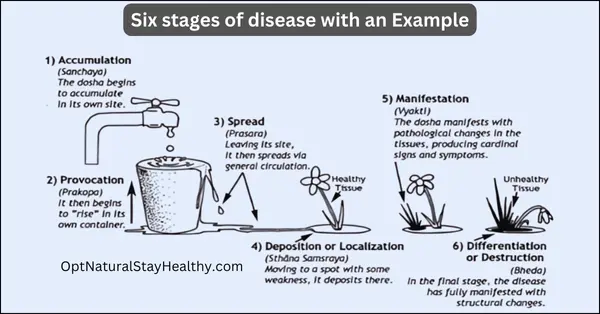
Final words about the six stages of the disease
Stages one and two are always easier to treat. Stage three is the transitional stage. When the doshas enter the fourth stage, it’s still treatable with the body’s natural repair mechanism. Stages 5 and 6 are far too challenging to treat.
This is the reason why Ayurveda emphasises the prevention of the disease in the early stages. Moreover, Ayurveda says that the imbalance of the three doshas causes all the diseases.
Hence, following a proper healthy diet and lifestyle as per Ayurvedic principles will help prevent the diseases at stage 1 (Sanchya or accumulation stage). There will be no chance of aggravation of the doshas, and if there is no aggravation of the doshas, a disease will not manifest, and a person will be healthy and happy.
Kriyakala can be subdivided into two stages: 1) Doshaja Kriya Kala: The treatment is given according to the involvement of Doshas, it includes Sanchaya, Prakopa, and Prasara stages. 2) Vyadhi Kriya Kala: The treatment is given according to the disease, it includes Sthana Samshraya, Vyakti, and Bheda stages.[3]
Following the Ayurvedic principles, according to the dosha predominance or Prakriti, will ensure all three doshas are balanced, and the person will be healthy and will not suffer from any diseases.
Conclusion
Understanding the 3 root causes and 6 stages of disease helps to make better lifestyle choices. You can detect the signs of a disease early, hence you can intervene. You can stop the disease before it takes an abysmal form.
Reference
[1] Gupta S, Yadav SS. Insight of Trividha Roga Ayatana (Three principal causes of diseases) mentioned in Ayurveda. Int J Health Sci Res. 2021 Dec;11(12):42–6. Available from: Link to Study. <Go to Citation>
[2] Bishnoi N, Meena S, Sharma MM. Kriyakala in Ayurveda: Understanding disease progression for precise treatments. J Ayurveda Integr Med Sci [Internet]. 2024Feb.24 [cited 2025Jul.8];9(1):104 -112. Available from: Link to Study. <Go to Citation>
[3] Rathour G. Concept and significance of Shatkriyakala. J Ayu Int Med Sci. 2024;9(4):155-158. Available from: Link to study. <Go to Citation>

